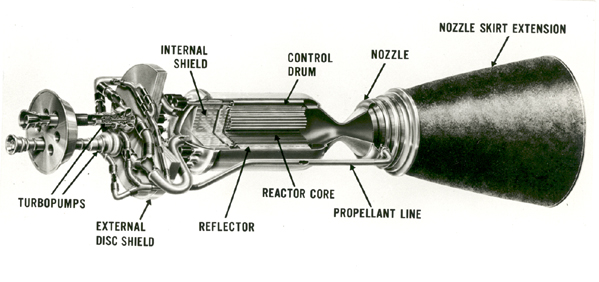Nuclear Fission Rocket Engines
Nuclear-fission rocket engines utilize the same technology as fission power plants. Heavy atoms, such as Uranium or Plutonium, are split into lighter atoms releasing the nuclear energy that held the larger cores of the heavier atoms together. The energy released is in the form of intense heat which is used to superheat the reaction mass and eject it at very high exhaust velocities. Thrust of a nuclear-fission rocket is about the same as a chemical rocket engine, but specific impulse (Isp) is greater. (Specific impulse is the amount of thrust you get for the weight of fuel you burn. A rocket with a high specific impulse doesn't need as much fuel as a rocket with low specific impulse to reach a given velocity.) Typically, the reaction mass flows directly through solid-core reactors and some fluid-core designs. In the case of gaseous-core fission drives, the heat transfer is by radiation across a transparent, heat resistant ceramic containment vessel. Liquid hydrogen, water and sometimes carbon dioxide are normally used as reaction mass.

NOTICE: The above image has been released into the public domain by the copyright holder, its copyright has expired, or it is ineligible for copyright. This applies worldwide.
With a solid-core reactor drive Isp of up to 1100 sec can be reached. Using a fluid-core drive Isp between 1200 sec and 1500 sec are possible. With a gaseous-core drive Isp from 3000 sec to 7000 sec and higher may be attained. The high Isp of gaseous-core drives make them ideal for interplanetary flight. Unfortunately, the exhaust gas of a nuclear-fission rocket is highly radioactive due to passage through the reactor core. This is one reason spaceports are normally located away from populated areas.
BACK TO